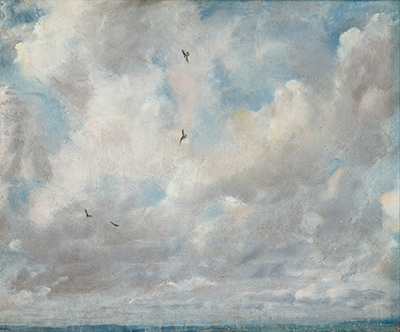During 1821 and 1822 Constable produced a large number of oil sketches of clouds and skies, making notes for each one relating to weather conditions and the time of day they were painted. He painted quickly but with precision, to capture as closely as possible the detail he observed.
He was one of the first artists to work using oils in the open air (‘en plein-air’), transferring what he could see directly onto paper or canvas. Some of the pictures included little clues and reminders of the earth below; treetops and birds in flight, but Constable’s focus was on the sky and, more importantly, the cloud formations as they drifted or blew over him.
His famed larger landscapes are busy and full of detail. By contrast his cloud studies are full of very little at all, lightly floating, apparently insubstantial, and yet they have the same ability as their creator’s solid, earth bound works to captivate anyone who looks upon them.
Cloud Study, 1821 (Oil on Paper Laid Down on Board) is part of the Paul Mellon collection at the Yale Center for British Art in New Haven, Connecticut. It shows an uncanny understanding of the ephemeral nature and structure of a cloud formation with just a fraction of detail at the base of the painting to anchor sky to earth.
The variations of light to dark, greys skimming across white, overlaying infinite shades of blue, have a subtle, hypnotic ability to draw in the observer, so that it is possible to lose oneself and, with the birds in the painting, soar up to the heavens, blissfully unaware of anything else. Constable referred to the time he spent painting the skies as ‘skying’, and this timeless cloud study allows us all to indulge in some ‘skying’ in the spirit of the artist.
The art historian; Ernst Gombrich, wrote that Constable refused to be more impressive than nature and Constable’s cloud studies illustrate just how hugely impressive nature, in its simplest form, can be.
John Constable (1776 – 1837) is one of Great Britain’s best loved landscape painters, with prints of works such as Flatford Mill and The Hay Wain decorating endless biscuit tins and placemats around the world.
But this great artist created so much more than might be suggested by his most famous works. Constable said that painting was another word for feeling, and his cloud studies certainly bear witness to this idea. He believed in a scientific, as well as poetic, approach to painting landscapes, and he thought that one should paint real life and not just from the imagination.




